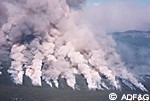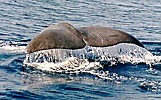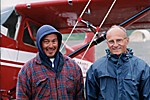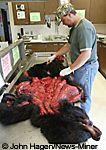Alaska Fish & Wildlife News
August 2003
Regeneration Following Fire
Creates Fertile Habitat for Wildlife

Tom Paragi wants to see 50,000 acres of Alaska forest burn this summer.
"We've planned this fire since 1995 and we're sure hoping to have it happen," said Paragi, a wildlife biologist with the Alaska Department of Fish and Game in Fairbanks.
The fire slated for the Tanana Flats near Fairbanks is a prescribed burn, a carefully planned and executed operation to enhance wildlife habitat. Moose and grouse flourish in the fertile environment of regeneration that follows a ...
Benefits of Fire ArticleContinued
Sperm Whales Awe and Vex Alaska Fishermen

Fisherman Sean Tracey was working aboard the Connie M when the big sperm whale surfaced and settled in next to the boat. The 50-foot whale rested against the 42-foot fishing boat while three smaller whales picked black cod off the longline gear.
"That one didn't ever dive, he just hung out while the others were eating," Tracey said. "It was just sitting at the surface, lying right up against the boat. I was cleaning the deck and I touched him with the broom handle, then I ...
Sperm Whales ArticleContinued
John Coady
Flying Biologist Wraps up 32 Years of Service

John Coady spent much of the past month in an airplane, flying over caribou in Northwest Alaska. Coady a pilot, biologist, and administrator wraps up 32 years of service to Fish and Game this summer. It's fitting that caribou and piloting make up his last weeks with the Department.
Caribou, especially the large Western Arctic Herd, have been a big part of John Coady's world for the past three decades. He's seen migrating caribou envelope entire herds of reindeer domestic caribou - and completely ...
Coady Leaves Legacy ArticleContinued
State Sealer Knows His Bear Necessities

Tony Hollis can tell a lot about a bear just by looking at its hide, teeth, nose and ears.
The big black bear that Roger Piek brought in on a recent morning, for example, had several scars on its nose, including a fresh one in the form of a small hole on the end of its snout.
"This one has been fighting this year already," Hollis said, examining the small wound. "It's pretty common to see scars on faces."
The same goes for rips in ears. Sure enough, ...
Skulls and Hides ArticleContinued
